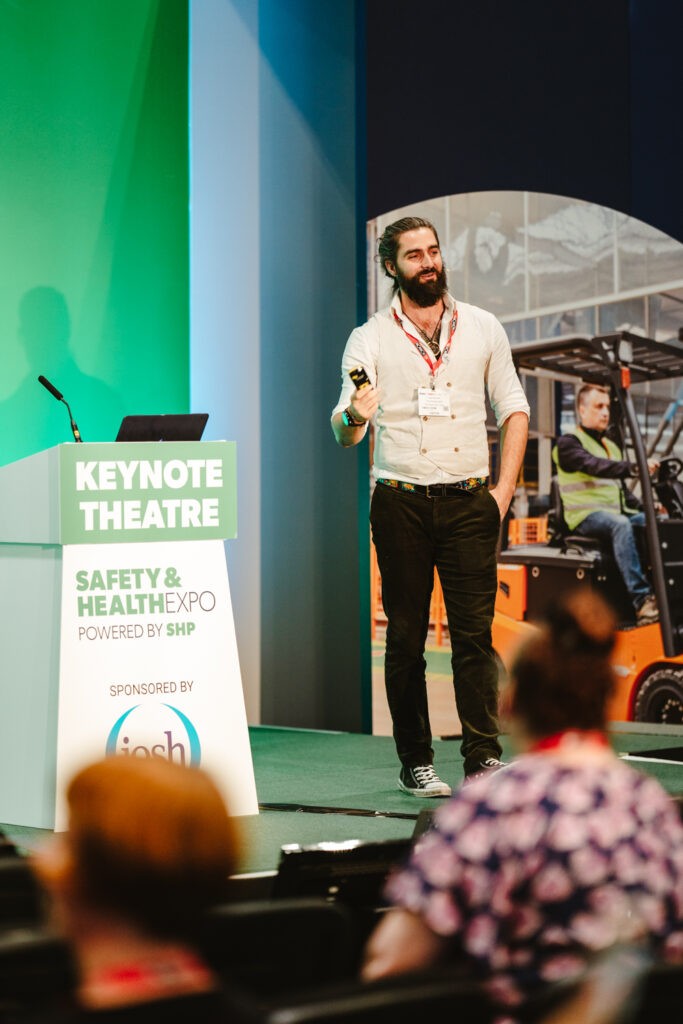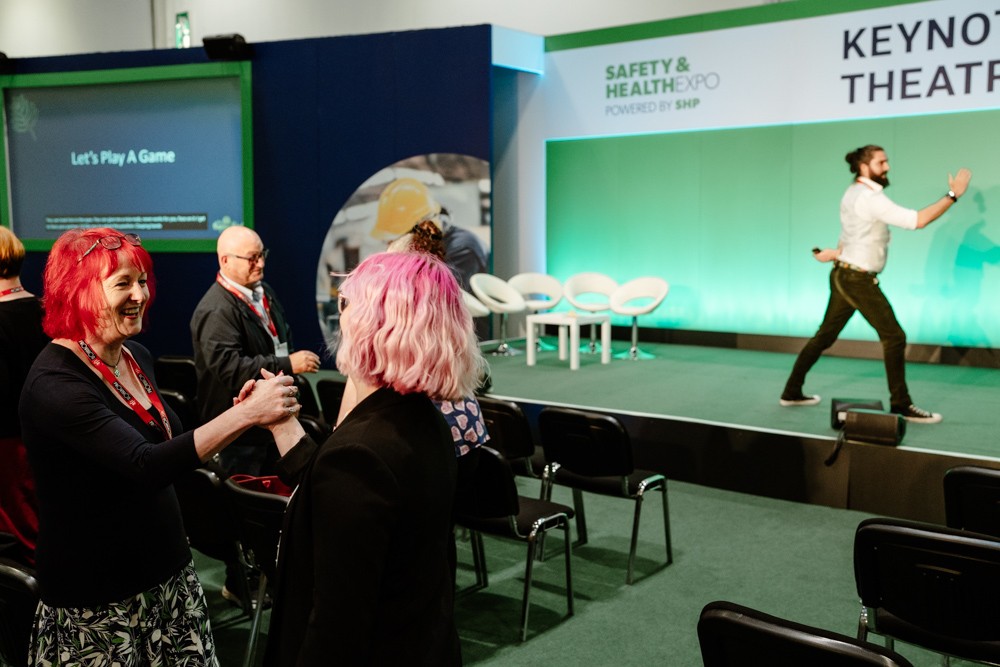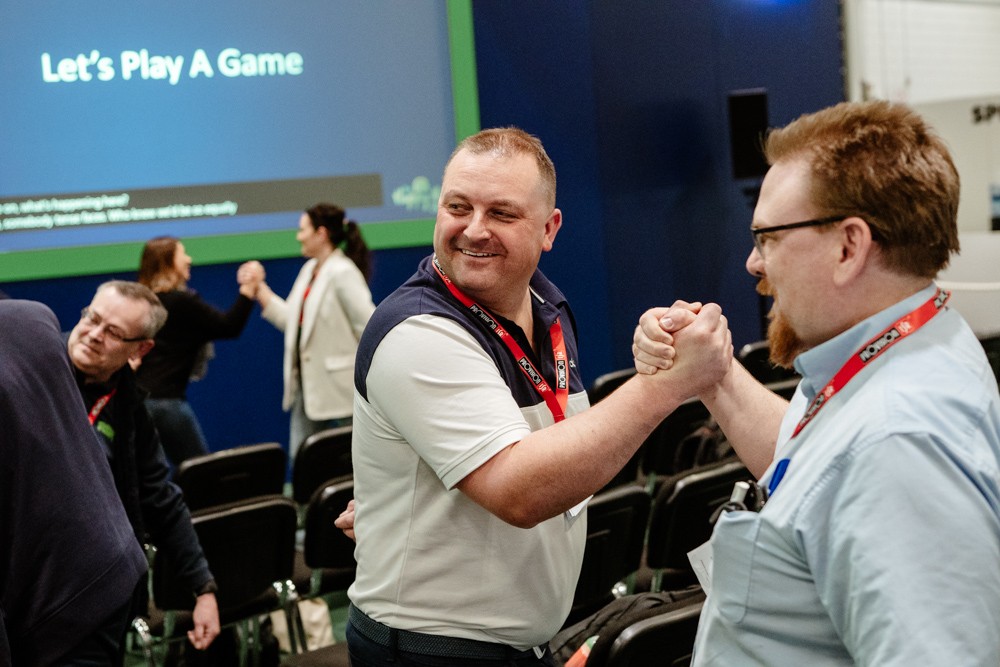Hugo Metcalfe is a seasoned psychologist and culture specialist, with a background in psychology and psychotherapy. Early in his career he worked with criminal populations in South London and in prisons around the area, having studied forensic psychology. He later studied clinical psychology and worked in the NHS, where he supported adults, children, and young people.

Hugo Metcalfe presenting at Safety & Health Expo 2023
Hugo’s passion for making complex psychological ideas practical and usable led him to co-found The Happy Mind Tribe, a consulting company that supports organisations by transforming psychological evidence into actionable strategies. As the company’s chief psychologist, Hugo specialises in workshops, training, and consultancy around leadership and cultivating sustainable wellbeing cultures. He has spent extensive time working with the British military and a range of other organisations.
According to Hugo, cultures that work well don’t require constant training to remain functional. His goal is to encourage psychologically informed workplaces and share his knowledge on this subject to make a positive difference.
Following is keynote talk at Safety & Health Expo in London today, I sat down with him to delve into some of the areas he covered in his presentation.
Charlotte Geoghegan: When you talk about wellbeing culture, what do you mean by that?
Hugo Metcalfe: People often separate the ideas of organisational culture their lovely wellbeing initiatives & strategies. But in reality, these things are completely interconnected. A strong culture that supports and encourages positive wellbeing is crucial for the overall success of an organisation.
In the past, there was a misguided focus on performance goals and outcomes, with wellbeing being an afterthought. However, this perspective is changing for the better. When staff members have good wellbeing, they are happier and more connected, which ultimately leads to better performance outcomes.
Therefore, it’s important to make wellbeing a key performance indicator (KPI) and prioritise it alongside other goals. By doing so, organisations can create a wellbeing culture that benefits both their staff and their overall success.
CG: What is real organisational culture?
HM: Some HR teams might say their organisational culture is about kindness, justice, growth. You know, these lovely, big things that look good to stick on a website. Culture is often portrayed as big, lofty ideals, but it’s really about the relationships between people and how they interact within the organisation.
If I asked you, would you be happy if your kids got a job at this company? Your answer would tell me a lot more about your organisational culture than the words HR have come up with on their posters.
CG: You say that ‘who makes the tea at work’ matters. Why? And what does that have to do with workplace wellbeing systems?
HM: In my keynote at the Safety & Health Expo, I will be discussed an important concept called organisational citizenship. This refers to the small actions that we do for our organisation and colleagues, which aren’t required by our contracts but build connection, attachment, and a sense of belonging.
For example, think back to the heady days when we were in the office five days a week. Your colleague, let’s call him John, would offer you a cup of tea every day when he went to the kitchen. You’d always gladly accept. If one day if John didn’t offer you a cup of tea, you would immediately know that something was up. This is an example of one of the tiny behaviours which contributes to an organisation’s culture.
Organisational citizenship is about the people who stay an extra five minutes after a meeting, the person who waters the plants, your colleague who brings in biscuits or someone who organises the staff social events. It’s these small gestures that bind us together as a group and create a strong culture.
Your organisation’s culture is not the values printed on a poster your HR department. It’s about understanding the little pieces that make up the whole. This is where holistic thinking comes in.
Holistic thinking is about understanding how the system functions as a whole and how different systems within it are interconnected.
By adopting a systemic approach and understanding how the different pieces of your organisation fit together, you can create a more sustainable wellbeing culture that benefits everyone.

Hugo Metcalfe’s keynote seminar in action at Safety & Health Expo 2023
CG: What’s the difference between reductionist and holistic thinking?
HM: Many organisations tend to rely on plugging in interventions to fix specific problems. This approach is known as reductionist thinking, where you break something down into its component parts and try to solve each problem individually.
For example, if your sales team isn’t bringing in enough revenue, you might assume that they need more training in objection handling, sales strategy, or closing deals. However, taking a holistic approach would involve asking why sales aren’t making more sales. This might lead you to discover that customers aren’t coming through the door because your organisation is no longer competitive in the marketplace.
By digging deeper, you might find that your suppliers have increased their costs due to terrible working conditions. If this is the case, no amount of sales training will solve the underlying problem.
To truly understand your organisation, you need to adopt a systemic approach that considers how different systems within it are interconnected. This is where systemic thinking comes in. By understanding how your organisation functions as a whole, you can create a sustainable impact that benefits everyone. Remember that your organisation is not just a set of rules, plans, contracts, or values on a wall. It’s made up of all the pieces within it that connect and relate to one another, making it tick and work effectively.
CG: Can you give examples of organisations that have successfully implemented a holistic approach to wellbeing culture?
HM: Years ago, while conducting mental health training at an organisation, I was shown an accident form that caught my attention. The form for warehouse accidents included the question ‘How are things at home?’. With that simple question, they were acknowledging that an employee’s’ home life, mental health, and social relationships can impact their safety at work and possibly increase the likelihood of accidents. It struck me as really clever forward thinking, taking a helicopter view to understand the broader picture.
This made me think more about the fact that accidents in the workplace may not always be caused by physical hazards alone. For instance, an employee falling off a ladder could be as result of stress, personal struggles, or other psychological factors, rather than a problem with the ladders. This reinforced my belief that mental health and psychological safety should be an integral part of workplace safety. I firmly believe the two go hand-in-hand.
To answer your question from a slightly different angle, many organisations can make improvements to wellbeing culture more easily from the edges of the workforce rather than the top. And another interesting company I worked with (a big media company) had an issue with siloes. In the company we could have forced employees to work together on group projects, but instead, we decided to try a no-fail experiment. We offered employees a free coffee voucher if they took someone from another part of the business out for coffee with them. This simple intervention led to greater inter-group working and collaboration, without the need for a top-down approach.
Similarly, another company I worked with was struggled with getting buy-in for their wellbeing initiatives. To address this, they created a gamification system where employees earned points for activities like going for a jog, having a smoothie, or attending a wellbeing workshop. These points added up and led to prizes, creating a sense of friendly competition and motivation to prioritise wellbeing.
Both of these interventions were low-cost and low-effort, but they had a huge impact on the organisational culture.
So instead of sitting in the problem, we come up a little bit and look at the problem from above and you can see slightly differently.

Hugo Metcalfe’s keynote session in action at Safety & Health Expo 2023
CG: How can health & safety professionals kick-start a plan around improving workplace wellbeing culture if they don’t have support of senior management?
HM: When it comes to implementing a new wellbeing strategy in the workplace, a classic top-down approach often isn’t needed. A top-down approach tends to involve strategising, implementing, and waiting to see if it works. If it doesn’t, the organisation comes up with a new plan and starts the process again. This cycle can be frustrating and unproductive.
Instead, a better process involves evaluating, analysing, strategising, implementing, re-evaluating, and checking in. This approach allows organisations to continually improve their wellbeing strategies and make necessary adjustments along the way.
Measuring the success of wellbeing initiatives is also crucial for demonstrating added value through proper management. This doesn’t have to be a complicated process, and we’ll discuss how to measure the impact of wellbeing initiatives at Safety & Health Expo.
Another important concept is the idea of a no-fail experiment. By engaging in simple experiments that don’t cost anything, organisations can start to shift the system from the edges, even if they don’t have central buy-in. We’ll explore this idea and discuss how to sell a systemic approach or intervention to leadership.
CG: You said that being sustainable means you shouldn’t require constant training. Tell me more about that word sustainable and why that’s an important part of workplace wellbeing culture.
HM: For the line of work that I’m in, it’s terrible for me to say this, but you don’t need to spend lots of time and money on constant training. I often tell my clients, once you’ve done some work and put things in place, you don’t need to see me again!
Investing in constant training should not be necessary. If an organisation requires new rounds of wellbeing, leadership, or emotional intelligence training every year, it suggests that something has gone wrong with their system. Instead, you can create sustainable systems that self-regulate to a certain extent, systems that make it straightforward to identify issues and solve them effectively.
By creating a sustainable system, you can save time and money in the long run. Rather than constantly relying on external training, your organisation can develop its own internal resources and expertise. This approach not only benefits your bottom line, but it also creates a more self-sufficient and empowered workforce.
CG: Why did you choose to speak at Safety & Health Expo again this year?
HM: The event is filled with people who are looking for change. They’re looking for things to be different, and they’re coming looking for that inspiration or ideas, which is great. It’s lovely to be around people who are curious about change.
By promoting mental health and psychological safety in the workplace, I feel organisations can create a safer and more supportive environment for their employees. Ultimately, including psychological safety in safety measures can lead to improved employee well-being, productivity, and overall success for all.
What makes us susceptible to burnout?
In this episode of the Safety & Health Podcast, ‘Burnout, stress and being human’, Heather Beach is joined by Stacy Thomson to discuss burnout, perfectionism and how to deal with burnout as an individual, as management and as an organisation.
We provide an insight on how to tackle burnout and why mental health is such a taboo subject, particularly in the workplace.




